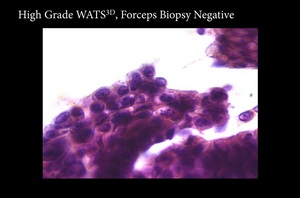SUFFERN, NY--(Marketwired - May 5, 2014) - CDx Diagnostics today announced results from a study demonstrating that adjunctive use of the WATS3D biopsy markedly increases detection of esophageal pre-cancer in community-based settings. The results were presented during a Presidential Plenary Session at Digestive Disease Week® 2014 (DDW) on May 4, 2014 in Chicago.
The WATS3D biopsy collects a wide area, disaggregated tissue specimen of the entire thickness of the suspect epithelium. This unique tissue specimen is then subjected to specialized, computer-assisted 3-dimensional analysis to pinpoint potentially abnormal cells for presentation to a pathologist.
"In light of recent studies and changes to Barrett's esophagus management guidelines, improved dysplasia detection is critical to appropriately managing these pre-cancerous lesions so that we can ultimately improve patient outcomes," said lead author Seth Gross, MD, NYU Langone Medical Center. "The current 4-quadrant forceps biopsy standard method for diagnosing Barrett's esophagus leaves a large amount of unsampled tissue which could be harboring more advanced pre-cancer. WATS3D addresses this challenge by complementing the forceps biopsy with a more robust sampling method and computer-assisted analysis using a neural network to identify the most suspicious cells."
The study, which included data from more than 2,500 patients tested by 28 gastroenterologists, found that adding the WATS3D procedure to standard forceps biopsy sampling of the esophagus significantly increased the detection of both Barrett's esophagus and esophageal dysplasia. WATS3D identified 258 additional cases of Barrett's esophagus for an increased detection yield of 68.4%. WATS3D also detected 10 additional cases of dysplasia and one additional cancer missed by forceps biopsy for an increased detection rate of 64.7%.
The authors concluded that widespread use of WATS3D in community-based gastroenterology practices helps identify dysplasia missed by forceps biopsy, which could improve patient care.
Michael Smith, MD, MBA, of the Temple University School of Medicine added, "Innovation in health care has the greatest impact when it improves everyday clinical practice. These data, which come from community-based gastroenterology cases, clearly show that using WATS3D during upper endoscopy significantly enhances the ability to detect dysplasia within Barrett's esophagus in a real-world setting. Given how quickly and easily this technique can be used, I expect that even more gastroenterologists will incorporate WATS3D into their endoscopic protocols."
DDW attendees can visit booth # 2711 to learn more about WATS3D.
About CDx Diagnostics and the WATS3D Biopsy
CDx Diagnostics' mission is to provide doctors with the most powerful diagnostic technology to help prevent cancer before it can start.
CDx Diagnostics' WATS3D biopsy addresses the sampling error inherent in random forceps biopsy testing of the esophagus. In just a few minutes, gastroenterologists can easily obtain a wide area, full-thickness transepithelial tissue sample for computer-assisted 3D laboratory analysis. In clinical trials, adjunctive use of CDx Diagnostics' WATS3D biopsy significantly increased the detection rate of both Barrett's esophagus and esophageal dysplasia. The high sensitivity of WATS3D is due to the large tissue area sampled, and the proprietary 3-Dimensionial computer imaging system that is based on an algorithm developed as part of the U.S. Strategic Defense Initiative missile defense program. To learn more about WATS3D, visit www.WATS3D.com.
About Digestive Disease Week®
Digestive Disease Week® (DDW®) is the largest international gathering of physicians, researchers and academics in the fields of gastroenterology, hepatology, endoscopy and gastrointestinal surgery. Jointly sponsored by the American Association for the Study of Liver Diseases (AASLD), the American Gastroenterological Association (AGA) Institute, the American Society for Gastrointestinal Endoscopy (ASGE) and the Society for Surgery of the Alimentary Tract (SSAT), DDW takes place May 3 - 6, 2014, at McCormick Place, Chicago, IL. The meeting showcases more than 5,000 abstracts and hundreds of lectures on the latest advances in GI research, medicine and technology. More information can be found at www.ddw.org.
Contact Information:
Contact:
Chantal Beaudry or Christopher Frates for CDx Diagnostics
cbeaudry@lazarpartners.com
cmfrates@lazarpartners.com
212-867-1762
